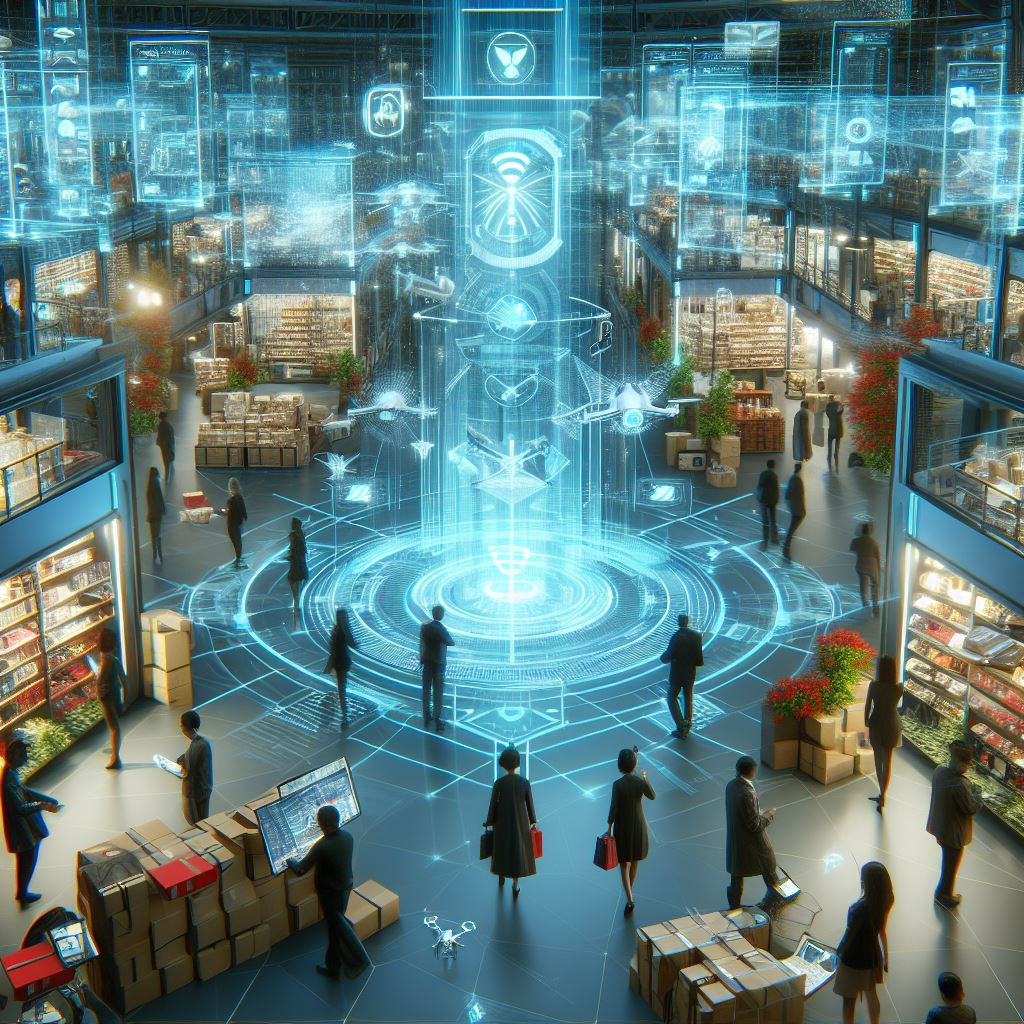The concept of “Place” in the marketing mix encapsulates the strategies businesses use to make their products available to consumers. It encompasses not only the physical locations where products can be bought but also the distribution channels that products traverse from the manufacturer to the consumer. Understanding this journey is crucial for businesses aiming to optimize their supply chain, enhance customer satisfaction, and achieve competitive advantage.
Physical Location
The physical location refers to the actual places where products are sold to consumers. These can vary widely, including:
- Retail Stores: Traditional brick-and-mortar stores where customers can physically browse and purchase products.
- Online Marketplaces: Digital platforms like Amazon, eBay, or company-specific e-commerce sites where consumers can order products online.
- Pop-up Shops: Temporary retail spaces that allow brands to interact with customers in person, often used for promoting new products or testing new markets.
- Vending Machines: Automated machines placed in high-traffic areas for convenient access to products like snacks, beverages, or electronics.
Distribution Channels
Distribution channels describe the path a product takes from the manufacturer to the end consumer. This path can involve several intermediaries, each playing a crucial role in ensuring the product’s availability to the target market. The common routes in the consumer market include:
Direct Channel (Manufacturer → Consumer): Involves selling products directly to consumers, bypassing any intermediaries. Examples include brand-owned online stores or factory outlets where consumers can purchase goods directly from the brand.
One-Level Channel (Manufacturer → Retailer → Consumer): The manufacturer sells products to retailers, who then sell to consumers. This is common in consumer electronics, where manufacturers like Sony sell their products through electronics retailers.
Two-Level Channel (Manufacturer → Wholesaler → Retailer → Consumer): Involves wholesalers who buy large quantities of products from manufacturers and sell them to retailers, who then sell to consumers. This is typical in the grocery industry, where manufacturers sell to wholesalers, which then distribute products to various supermarkets.
Three-Level Channel (Manufacturer → Agent → Wholesaler → Retailer → Consumer): Adds an agent or broker into the mix, who facilitates the distribution process between manufacturers and wholesalers, especially in international markets or where manufacturers lack direct access to large wholesalers or retailers.
Factors Influencing the Choice of Distribution Channels
- Product Characteristics: Perishable goods require faster, more direct channels, whereas durable goods can go through longer channels.
- Market Factors: The size and geographic dispersion of the target market influence channel length. Niche markets may benefit from direct sales, while mass markets often utilize longer channels.
- Company Objectives: A brand focusing on control and brand image might prefer direct channels, while one aiming for wide market coverage might use extensive distribution networks.
- Cost Considerations: Direct channels may offer higher margins but come with higher operational costs. Indirect channels reduce the burden on the manufacturer but at the expense of lower margins.

- Manufacturers to consumers.
- Manufacturer to consumer via retailer.
- Manufacturer to consumers via wholesalers and retailers.
- Manufacturer to consumer via agents and/or wholesalers and retailers.
How do businesses choose a particular distribution channel and what determines their advantages/disadvantages?
Costs: the longer the supply chain, the greater may the cost to the final consumer be.
Control: some manufacturers want to control the distribution channels they use carefully.
Legal factors: the law may affect how a product is distributed.
Effectiveness of different distribution channels
↓
Wholesalers
- Bear storage costs.
- Lower transaction costs as wholesalers are the customer.
- Time is freed up for manufactures to focus on production not distribution.
↓
Distributors are independent specialist businesses that trade in the products of only a few manufacturers.
Agents are negotiators who act on behalf of companies to sell the products. They are often experts, who are given a commission for their services.
Benefits of using wholesalers:
- Can use experts.
- Frees up time for producers to not spend on marketing products, rather producing.
↓
Retailers
Retailers play a crucial role in the distribution chain, acting as the final step before products reach the end consumer. They are, in essence, the storefronts that offer products from various manufacturers, allowing consumers to browse, compare, and purchase goods in a single location or through online platforms. Retailers can range from small, independent shops to global chain stores, each serving different market segments and consumer needs. Below is a detailed exploration of the various types of retailers.
Independent Retailers
Definition: Independent retailers are small business owners who operate on a local scale. They are often sole proprietors or family-run businesses, characterized by having a single outlet or a small number of outlets under the same ownership. These retailers typically focus on a niche market, offering a specialized range of products and personalized customer service.
Detail: An example includes a local independent bookstore that curates a selection of books based on community interests and preferences. Independent retailers often thrive by creating a personalized shopping experience, fostering customer loyalty, and responding quickly to local market trends.
Multiple Retailers
Definition: Also known as chain stores, multiple retailers consist of a network of branches operating under the same brand and management, offering consistent product ranges and shopping experiences across locations.
Detail: H&M is a prime example of a multiple retailer, with stores worldwide offering a standardized selection of fashion apparel. Multiple retailers benefit from economies of scale in purchasing and marketing, which can often lead to competitive pricing and brand recognition.
Supermarkets
Definition: Supermarkets are large retail outlets that primarily sell food and grocery items. They source products directly from manufacturers and producers, often bypassing wholesalers, to offer a wide variety of goods at competitive prices.
Detail: Tesco, a leading supermarket chain, offers an extensive range of food products, household goods, and often in-store pharmacies and banking services, catering to a broad spectrum of consumer needs. Supermarkets operate on thin margins and high volumes, emphasizing efficiency in inventory management and supply chain logistics.
Hypermarkets
Definition: Hypermarkets are vast retail spaces that combine supermarket and department store elements, offering an extensive range of products from groceries to consumer durables like electronics and clothing under one roof.
Detail: Walmart is a notable example, providing a one-stop shopping experience with a wide selection of products at low prices. Hypermarkets target price-sensitive consumers looking for convenience and value, capitalizing on their ability to drive significant foot traffic and sales volumes.
Department Stores
Definition: Department stores offer a wide range of products, including apparel, cosmetics, household goods, and appliances, organized into different sections or “departments” within a large retail space.
Detail: Macy’s exemplifies the department store model, offering diverse product categories and brands, along with services such as personal shopping assistance and in-store cafes. Department stores distinguish themselves through product variety, customer service, and often, a focus on higher-end or branded goods.
The “Place” component of the marketing mix, often referred to as distribution, plays a crucial role in ensuring the availability of a product or service to the target consumers at the right time, in the right place, and in the right quantities. It encompasses decisions related to physical locations—where products can be bought—and the selection of distribution channels that dictate how a product travels from the manufacturer to the consumer. This aspect of the marketing mix is critical because it directly impacts a product’s accessibility and its overall success in the market.
Physical Location
Physical location refers to the specific points of sale where products are made available to consumers. These locations can range from brick-and-mortar retail stores and pop-up shops to large-scale distribution centers that supply products to retailers. The choice of location is strategic and based on a thorough understanding of the target market, including consumer preferences, shopping behaviors, and geographical considerations. For instance, a luxury brand might choose to place its stores in high-end shopping districts to align with its brand image and target demographic, while an online retailer might focus on the strategic placement of warehouses to optimize delivery times.
Distribution Channels
Distribution channels are the pathways through which a product or service travels from the manufacturer to the end consumer. These channels can be direct or indirect:
Direct Distribution: Involves selling products directly to consumers without intermediaries. Examples include brand-owned retail stores, e-commerce websites, and direct mail. A prime example is Apple, which sells its products through its own retail stores and website, maintaining control over the customer experience.
Indirect Distribution: Involves one or more intermediaries, such as wholesalers, distributors, and retailers, who help move the product closer to the consumer. Most consumer goods manufacturers, like Procter & Gamble, use indirect distribution channels, leveraging the reach and infrastructure of established retailers to distribute their products.
Types of Distribution Strategies
Intensive Distribution: Aimed at maximizing product availability by placing it in as many outlets as possible. Common for consumer staples and products where convenience is key, such as Coca-Cola beverages.
Selective Distribution: Involves distributing products through a limited number of channels and outlets, selected based on their fit with the product’s positioning. This approach is often used for higher-end products that require a certain brand image or level of service, like certain electronics or fashion brands.
Exclusive Distribution: Grants exclusive rights to distribute the product in a specific geographical area to one or few retailers. This strategy is typical for luxury brands that wish to maintain a high level of control over how their products are sold, such as Rolex watches.
Challenges in Managing Place/Distribution
- Channel Conflict: Can arise when different distribution channels compete for the same sales, such as direct online sales undercutting traditional retailers.
- Logistics and Supply Chain Management: Ensuring timely delivery of products to various distribution points can be complex, especially for perishable goods or in international markets.
- Adapting to Consumer Trends: Shifts in consumer behavior, such as the increasing preference for online shopping, require businesses to adapt their distribution strategies accordingly.
Frequently Asked Questions about "Place" in Business
- Distribution channels (e.g., online, retail stores, wholesalers, direct sales).
- Logistics and supply chain management.
- Inventory management.
- Location (physical or online).
- **Target Market Proximity:** Is the location easily accessible to your customers?
- **Cost:** Rent/property prices, labor costs, taxes, utilities.
- **Talent Pool:** Availability of skilled employees.
- **Competition:** How many competitors are nearby?
- **Regulations & Permits:** Local zoning laws, business license requirements (like in Placer County).
- **Infrastructure:** Transportation, internet connectivity, supplier access.
- **Quality of Life:** Can attract and retain employees.
A **Blind Trust** is a specific type where the beneficiaries (like a public official) have no knowledge of the trustee's actions regarding the assets. This is often done to avoid conflicts of interest, as was the case with discussions around President Trump's business interests. It legally separates the individual from the management and knowledge of the specific investments within the trust.






